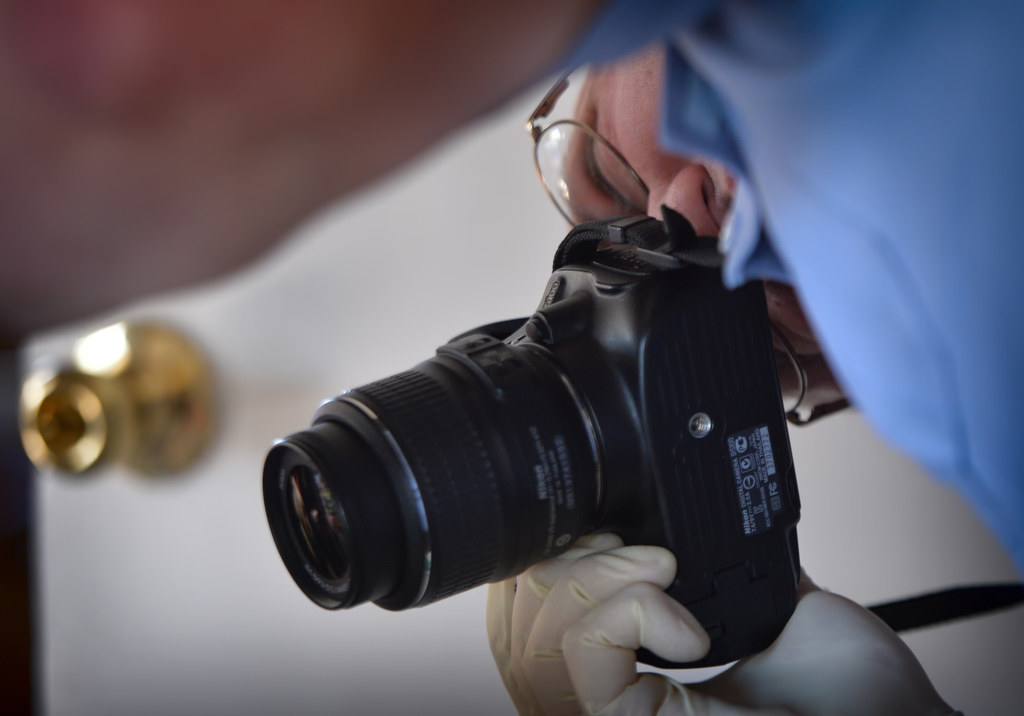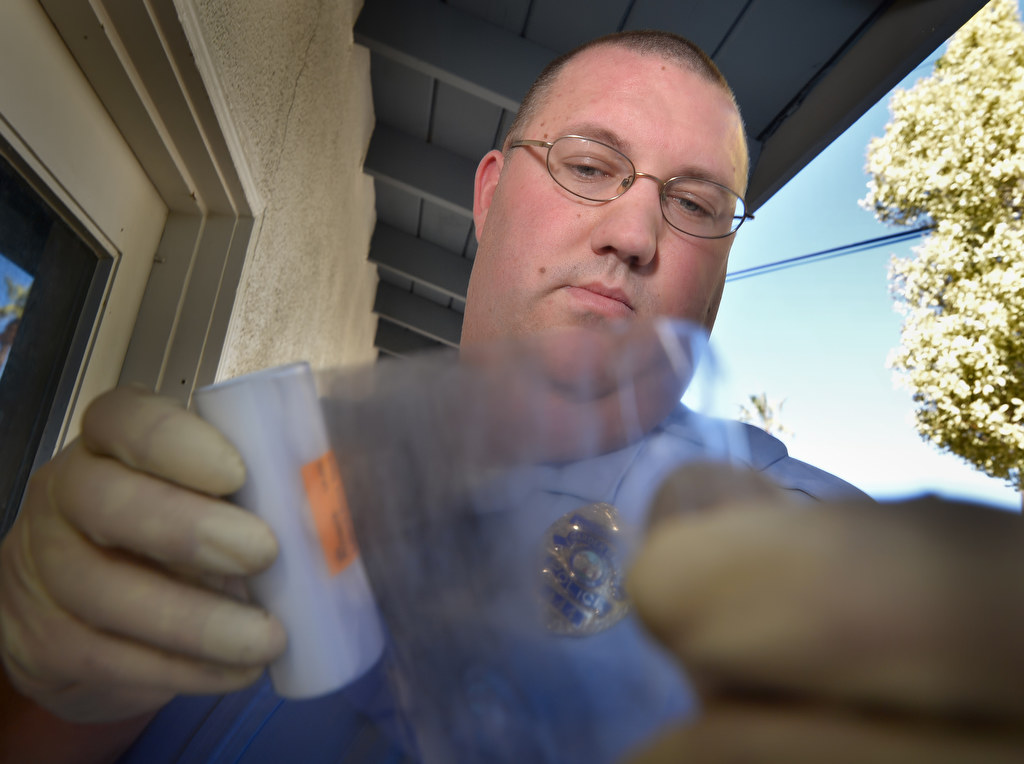The bad guy broke into the Garden Grove home from the backyard.
Kicked in a panel on a door to the garage.
Made off with a sleek new TV and antiques.
Total loss: $5,000.
This recent crime, which occurred in a long-vacant house in escrow in an older neighborhood on the west side of the city, upset the homeowner.
For Ryan Berleth, it was a garden-variety investigation; he sees such residential break-ins all the time.

Community Services Officer Ryan Berleth of the Garden Grove PD photographs evidence while investigating a break-in of a home in Garden Grove.
Photo by Steven Georges/Behind the Badge OC
After responding to the crime on a recent morning, Berleth took some photos.
He examined pry markings.
He dusted for fingerprints.
And then he prepared a report to hand over to a detective to begin the search for the criminal or criminals.
Berleth, 34, is a senior Community Services Officer with the GGPD, which just hired a fourth CSO.
And although CSOs often are thought of as civilian PD employees who primarily work traffic control, issue parking tickets and support sworn officers at large public events, they also work crime scene investigations.

Community Services Officer Ryan Berleth demonstrates one method of how fingerprint evidence can be lifted and stored using a special transparent tape.
Photo by Steven Georges/Behind the Badge OC
And at the GGPD, Berleth has a reputation for being skilled at getting good fingerprints.
In 2015, in fact, he racked up a record 14 fingerprint hits, meaning detectives located a suspect from latent prints he found at a crime scene.
That’s about double the average.
Most of Berleth’s 2015 fingerprint hits, which scored him an Employee of the Quarter award, were for residential and commercial burglaries.
Some were for robberies.
One print was found at the scene of a deliberately lit fire at a school.

Community Services Officer Ryan Berleth of the Garden Grove PD uses a magnet to move around black fingerprint powder while trying to bring out a boot print from a panel that was kicked in during a break-in of a home in Garden Grove.
Photo by Steven Georges/Behind the Badge OC
About half of Berleth’s job as a CSO involves crime scene work.
And he loves it.
A big clue is the tone on his cell phone when he gets a call:
The theme from “The X-Files.”
Says the former cadet who started working for the GGPD in 1999 (the only job he’s ever had): “I love the investigative aspect of my job.”
Berleth has been working in the field as a CSO for 12 years.
It’s meticulous, not-stop work that requires patience and persistence — and the carelessness of crooks who aren’t exactly careful about not leaving being evidence at crime scenes.

Community Services Officer Ryan Berleth of the Garden Grove PD photographs a boot print from a panel that was kicked in during a break-in of a home in Garden Grove.
Photo by Steven Georges/Behind the Badge OC
“A smart bad guy would wear a full body suit and burn and trash everything after he is done with (committing a crime),” Berleth says.
“Luckily, most bad guys aren’t smart.”
***
In the case of the recent garage break-in, the perp left behind two shoe prints on the panel of the door he kicked in.
“These look like boots,” Berleth said after dusting the door panel.
“A lot of people don’t know this,” Berleth adds, “but shoeprints have details in them just like fingerprints do. There are marks, there are scuffs, and there are scratches. And there’s debris left behind from the bottom of a shoe that is unique to a shoe.”
The burglar or burglars tried to pry open a door from inside the garage that leads to the house, as well as a window in the back yard, but never gained entry to the home. The homeowners confirmed nothing was missing inside the house — just from the garage.
Berleth, a graduate of Foothill High School in Tustin who played water polo and basketball in high school and attend Cal State Long Beach, got a taste for crime scene investigation about a year-and-a-half into his career at the GGPD.
After first working as a cadet assigned to property and evidence, Berleth started working with an Orange County Sheriff’s Department forensic specialist assigned full time to the GGPD.
Still a cadet, Berleth fell in love with forensics under the direction of then-GGPD forensics specialist Becki Daher, who retired in October 2014 and now is chairwoman of the Crime Scene Certification Board at the International Association for Identification in O.C.
Berleth now works closely with Daher’s successor, Debbie Mele.
After getting his feet wet in forensics as a cadet, Berleth transferred to the front desk. He then applied for the higher-paying position of CSO, got the job, and worked the front desk for another year before he started working in the field as a CSO in 2004.

Community Services Officer Ryan Berleth of the Garden Grove PD photographs fingerprints on a window he discovered while investigating a break-in of a home in Garden Grove.
Photo by Steven Georges/Behind the Badge OC
Berleth also is trained as a GGPD dispatcher and in Records, and is one of the agency’s handful of “super users” of the GGPD’s new computer system, Spillman.
“I absolutely love Garden Grove,” he says. “It’s a small department, and like a family. I’ve grown up with a lot of these people.”
***
As Officer Jason Johnson handled the crime report on the recent break-in, Berleth spent about 90 minutes combing the scene for evidence.
He used an old-school CSI kit: a 20-year-old green fishing tackle box passed down to him from a former CSI specialist.
Among the contents in the tackle box were measuring tape, brushes, fingerprint cards, deionized water for DNA testing, a wand for magnetic fingerprint powder, scalpels and normal black fingerprint powder.
There were no fancy chemicals or other sophisticated CSI tools — those are used on homicides and sex crimes and the like.
Berleth has advice for victims of residential or commercial break-ins (as well as vehicular burglaries):
“Don’t touch anything.”
Doing so could contaminate a crime scene and reduce the chance of finding good evidence, such as fingerprints.
Berleth didn’t find any prints at the two areas where the miscreant tried to gain entry into the Garden Grove home.
But the shoeprints were as solid leads.
“I would like nothing more than to fingerprint every square inch of every home I go to,” Berleth says, “but unfortunately I don’t have time for that.”
About two to three times a month, Berleth testifies in court.
He cited three cases he especially is proud of:
— Erick Mora was a prolific burglar who, in the summer of 2008, was hitting a lot of schools, swiping computers and other electronics. Three months into the crime spree, detectives got a hit on a latent fingerprint found in a church at one of the burglarized schools. This led to a search warrant being issued and a lot of evidence being uncovered that led to Mora’s arrest.
— On March 30, 2015, Leroy L. Doig Intermediate School was burglarized; the perps also started a small fire. They left behind several items as they fled. Berleth got a fingerprint hit on one of the items. The suspects were arrested.
— Berleth has a lot of friends who attend St. Paul’s Lutheran Church and School. In June 2015, burglars hit the school three times in a two-week period, stealing computers and tagging the school with graffiti. Berleth was able to obtain several fingerprints that led to the arrests of local gang members.
Berleth says anyone considering a career as a forensics specialists should keep a couple of things in mind.
First, you have to have a stomach for blood. Berleth’s worst call was a triple homicide that involved the torturing of a small child.
Second, you have to be able to chill.
“This is not a job you can rush,” Berleth says.
 Behind the Badge
Behind the Badge




